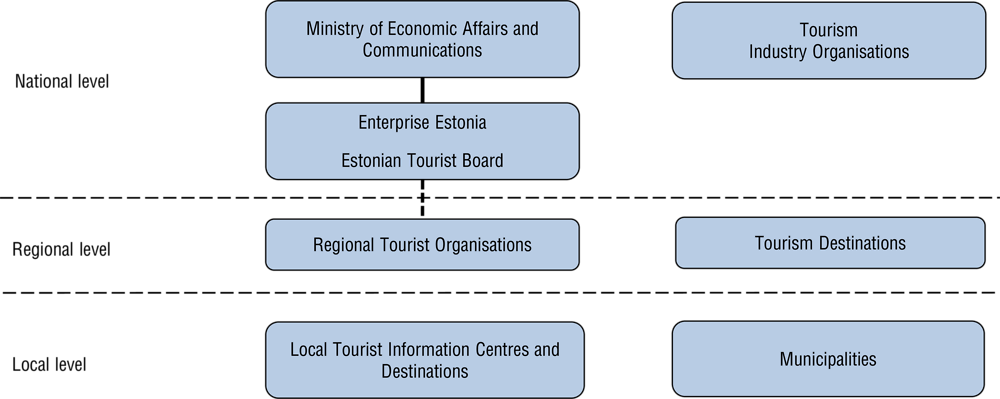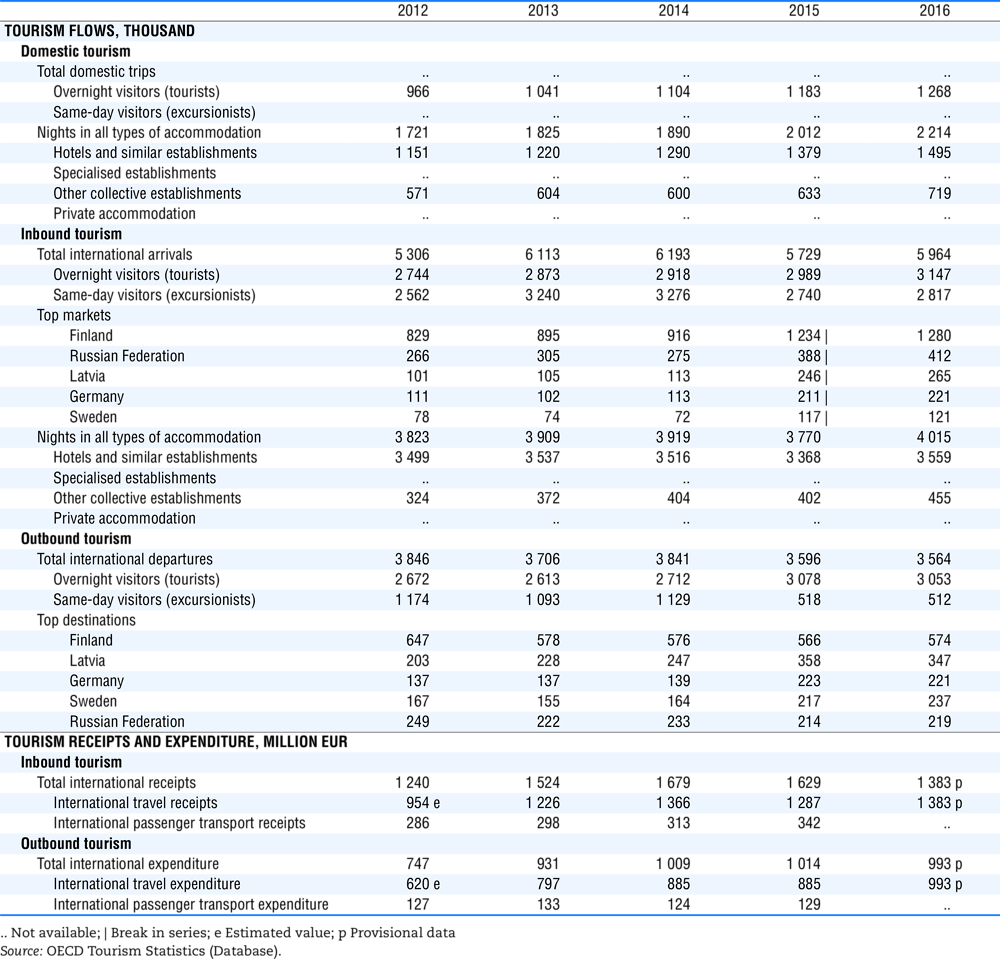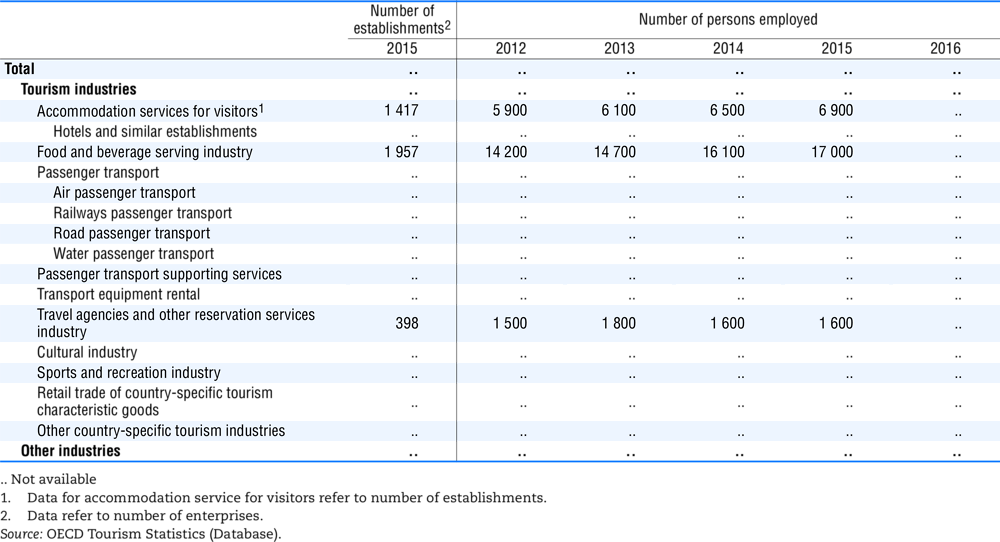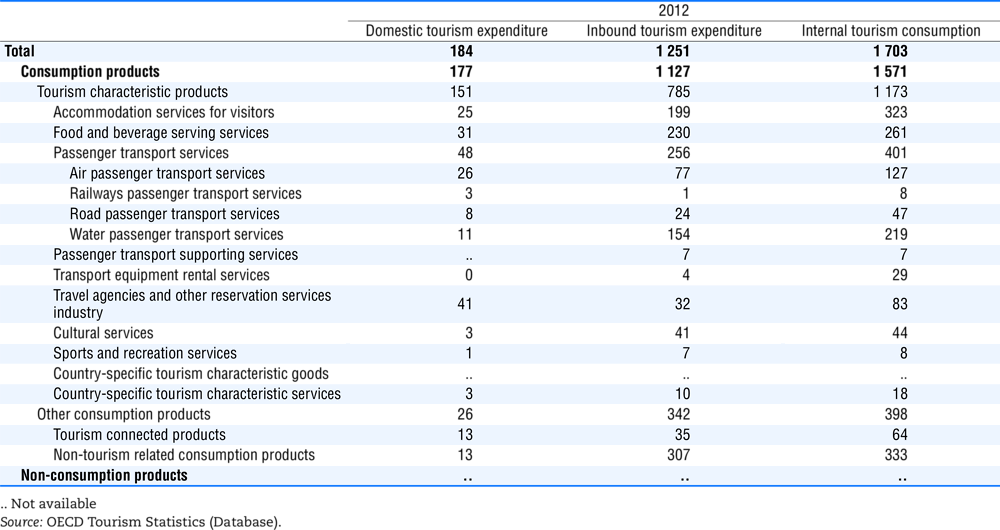Estonia
Tourism in the economy
In Estonia, both inbound and domestic tourism have seen steady growth. Taking direct and indirect impacts together, tourism contributed around 6% of GDP in 2016.
Nearly 6 million foreign visitors came to Estonia in 2016, up 4% on 2015, spending nearly EUR 1.4 billion on goods and services. Export revenues from tourism amounted to over EUR 1.7 billion and contributed 32% of services exports in 2016. Every fourth trip to Estonia was made from outside the European Union and the number of tourists arriving from Asian countries increased throughout the year.
Over 3 million domestic and foreign tourists stayed in accommodation establishments in 2016. Compared to 2015, numbers were up by 7% and nights spent increased by 8%. 64% of nights spent in Estonian accommodation establishments were attributable to foreign tourists, of which 63% were from the neighbouring countries of Finland, Russia and Latvia. Compared to 2015, the number of tourists arriving from Finland, Russia and Latvia increased by 5%, 8% and 11%, respectively.
Of the foreign tourists staying in accommodation establishments, 73% came to Estonia for a holiday, while 21% were on business. 62% of domestic tourists were on holiday.
Tourism governance and funding
National tourism policy and development activities are implemented by the Estonian Tourist Board, under the Enterprise Estonia Foundation, which in turn is administered by the Ministry of Economic Affairs and Communication.
Ministry activities include:
-
Setting tourism policies and programmes and overseeing their implementation,
-
Applying for funding from the state budget and the EU to deliver tourism development programmes and projects,
-
Drafting tourism-related legislation and regulations,
-
Participating in the activities of international tourism organisations,
-
Facilitating long term policy development through co-operation with a range of tourism stakeholders.
The Estonian Tourist Board undertakes international and domestic marketing and engages in product development. It also carries out market research in the main target markets and develops and administers the national tourist information service.
Other organisations involved at the national level are the Estonian Travel and Tourism Association, Estonian Hotel and Restaurant Association, Estonian Rural Tourism non-profit organisation, Tourism Foundations for north, south and west Estonia, Estonian Spa Association, and Estonian Convention Bureau.
Reform of local administration, including merging local municipalities, will have an effect on local level tourism organisations and their funding. The new National Tourism Strategy 2020+ (to follow the current Development Plan 2014-20) will take account of these changes.
Regional County development centres are located in all 15 counties, offering free advisory services to new and existing enterprises, local government and non-profit associations and foundations. They also engage in the management, dissemination and development of regional and national tourist information.
The overall budget for tourism development is stated in the National Tourism Development Plan for 2014-20 as approximately EUR 116 million, the majority of which is financed through Enterprise Estonia/Estonian Tourist Board. The main sources of funding for tourism development are EU structural funds and the state budget. All the measures and activities of the Estonian Tourist Board are evaluated through measurable indicators which are also set in the National Plan.
While there are no specific tourism taxes, in spring 2016, the Government took a decision to increase the value added tax for accommodation providers from 9% to 14% from 2017. However, this decision was subsequently rescinded, due to the possible negative impact on both the export of tourism services and domestic tourism.

Source: OECD, adapted from the Ministry of Economic Affairs and Communications, 2018.
Tourism policies and programmes
The main goal of the Estonian National Tourism Development Plan 2014-2020 is to ensure competitive and sustainable development of Estonia’s tourism sector. Current actions include:
-
Promotional activities to enhance Estonia’s position as a tourist destination,
-
Developing internationally attractive family tourism attractions,
-
Developing competitive (including regional) tourism products,
-
Better management of tourism information,
-
Monitoring tourism development,
-
Fostering international events.
Tourism in Estonia is recognised as an engine for employment, and a significant contributor to Estonia’s competitiveness, exports and economic growth. However, progress in tourism should be measured not only in increased number of visitors or overnight stays, but also through growth in overall tourism expenditure, increased quality of service and a greater diversity in the product offer. Recent investment in the tourism sector has been aimed at diversifying tourism attractions and motivating visitors to prolong their stay and increase return visits.
Awareness of Estonia as a travel destination remains low in Western and Southern European countries, pointing to an ongoing need to promote Estonia as an alternative to more traditional destinations. Promotional activities targeted toward long-haul markets such as China, Japan and USA are also carried out in co-operation with other Baltic countries and Nordic neighbours.
Growth in visitor numbers creates the preconditions for development of new international transportation routes, better connectivity and intermodal transport systems. An example is the Rail Baltic project, which is proposed as a modern and eco-friendly high-speed railway that will connect Estonia with its neighbours and with Central and Western Europe. Rail Baltic is one of the biggest investments in the coming years that will improve travel opportunities for Estonian people as well as developing business and trade, tourism and the exchange of goods. The railway route will ensure speeds of up to 240 km/h and provide the opportunity to travel comfortably and quickly to Latvia and Lithuania and onwards to Central Europe and beyond.
Implementation of the current National Tourism Development Plan 2014-2020 has largely been based on investment of EU structural funds. The underlying principle of the plan is to offer a high quality visitor experience that builds on welcoming and safe tourist routes accessible to people of all ages and abilities.
Some specific initiatives to date have included:
-
Developing Estonia as an attractive conference destination and addressing seasonality by continuing to support international conferences and large scale events. As part of this initiative, the development of a major conference centre in Tallinn is planned and will be funded from the state budget,
-
Infrastructure investment in new family tourism attractions to diversify the regional tourism offer,
-
Further development of coastal and marine tourism, including support for development of the small harbour network,
-
Organising Baltic Connecting 2017, an event focused on long-haul markets which aims to inform foreign travel trade professionals about tourism opportunities in Estonia, Latvia and Lithuania.
A review of the plan will be undertaken in 2018, together with planning and consultation for a new long-term National Tourism Strategy that will aim to further increase tourism income, investment to improve the quality of the tourism offer, and enhancement of unique local experiences. There is also a recognised need to develop Estonia as a sustainable tourism destination with the right balance between promoting tourism based on the country’s natural assets and action to protect these assets in the long term.
It will also be necessary to plan for a shift from EU funding to national funding, take account of emerging trends in European and global tourism, and take a whole-of-government policy approach to long-term sustainable tourism development.



